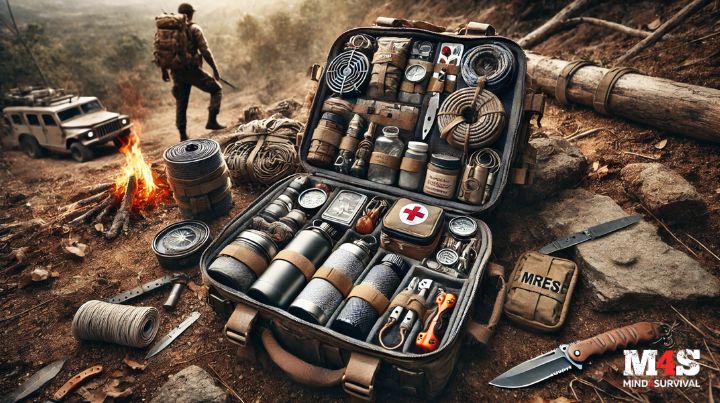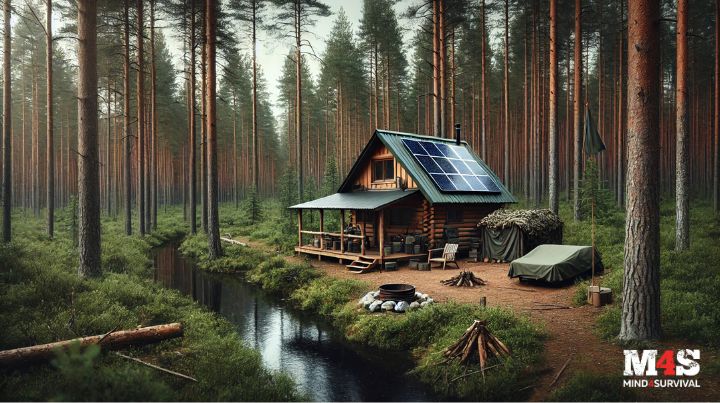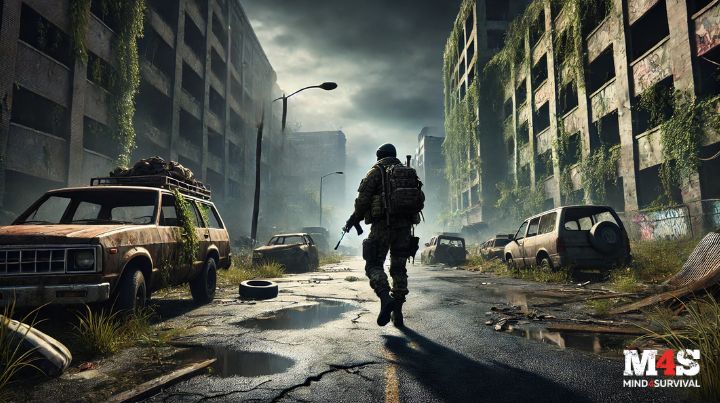Podcast: Play in new window | Download
When disaster strikes, having a designated bug-out location isn’t just a luxury—it’s a necessity for survival. Without a well-thought-out plan and a secure destination, you’re not bugging out—you’re simply becoming a refugee, probably one of many, with limited options and resources. A solid bug-out plan ensures safety, sustainability, and strategic advantage in emergencies, whether civil unrest, natural disasters, or long-term grid failures.
This article will break down key factors in choosing a bug-out location, helping you identify viable, secure, and practical options that fit your needs. It’s inspired by a great question from Facebook group member Jacqueline Blackford, who asked: “What is the ideal bug-out location—in your opinion?” Whether prepping for short-term evacuations or long-term survival, the information here will help you make informed decisions and avoid common mistakes that could put you at risk when it hits the fan.
If you haven’t yet joined the private Mind4Survival Facebook group, I suggest you do so by going to Facebook and searching for the Mind4Survival: Prepping Community.
Quick Look at What You’ll Learn
The Importance of Pre-Planning
Before we dive into specific locations, remember that preparation is essential. By pre-planning your bug-out options, you will increase your reaction time when a crisis hits while simultaneously decreasing the physical and mental stress you subject yourself and your loved ones to. When it comes to pre-planning your bug-out location, here’s what you need to do:
- Map out multiple evacuation routes beforehand and identify potential shelter locations along each path.
- Conduct map-based and physical reconnaissance of each site, evaluating them for shelter, security, rest areas, and available resources.
- Prepare sufficient supplies to sustain yourself for several days while minimizing the need to move around.
Legal Bug-Out Location Options
Having the legal right to an evacuation/bug-out location helps ensure you can stay in your bug-out location without legal issues and hassles with law enforcement or others, such as kicking you out.
1. Property You Own
This is your ideal option if you have a vacation home or undeveloped land. You have full legal rights to prepare the property in advance, store supplies, and make improvements as needed.
2. Rental/Lease Properties
Like owned property, long-term rentals or leased land, such as vacation homes, raw land (hunting camps), etc) provide a legal right to occupy the space. You can make reasonable preparations while maintaining your lease agreement.
3. Family and Friends’ Properties
When arranging to use someone else’s property as your bug-out location, remember:
- Get clear permission in advance: You can plan this ahead of time, and if conditions are right, prep this property ahead of time for your disaster hangout.
- While you don’t control this property, you should be able to generate plenty of goodwill by improving it and being a force multiplier for your friends and family.
- Don’t wear out your welcome. Treat it as if someone is doing something special for you—because they are.
4. Hotels and Motels
While accessible, hotels have significant drawbacks during emergencies:
- Maybe overcrowded during disasters: This can be dicey during a disaster when many people may be looking for a place to stay.
- Limited resources during grid-down scenarios
- Potential security concerns with other evacuees
- Risk of unsanitary conditions without running water during a grid-down situation.
5. Private Campgrounds
Private campgrounds are great options that offer several advantages:
- Access to facilities (restrooms, showers, laundry)
- Legal right to stay while paying fees
- Multiple accommodation options (RV, car, tent)
- Some have cabins and RV rentals available.
- Often, they have basic infrastructure.
6. Public Lands
Options include:
- Bureau of Land Management (BLM) dispersed camping areas (affordable extended stays). Generally, this type of camping has less support than a private camp. While it often does have water and latrines, there are no guarantees.
- State and National Forests (varying levels of facilities)
- Remote camping: You can also head off into the woods to set up a camp and try to get away from people. This requires more abilities, extensive preparations, and the ability to pack in your resources.
- Natural shelters like caves (need advanced outdoor skills)
7. Emergency Shelters
Red Cross and faith-based organizations provide:
- Basic necessities and support
- Medical assistance
- Temporary housing
- Note: It may take several days to become operational
Less Legal Bug Out Location Options
While this article provides a broad range of bug-out location options, it’s important to emphasize that some choices—such as abandoned buildings, utility easements, and roadside camping—come with serious legal and ethical risks. Trespassing on private or government-owned land can lead to arrest, fines, or even confrontations with law enforcement or property owners. Many areas are actively monitored or patrolled, and what may seem like an unoccupied building or open land could still be under legal ownership. Additionally, squatting in abandoned locations presents safety hazards such as structural instability, exposure to hazardous materials (asbestos, mold, chemicals), and potential conflicts with other desperate individuals who may already be occupying the space.
For those considering these options in a worst-case scenario, it’s essential to understand the potential consequences and to prioritize legal alternatives whenever possible. If survival demands an emergency shelter in a non-legal location, it should be a last resort, not a primary plan. Rather than risking legal trouble, focus on scouting public lands with legal camping options, securing agreements with property owners, or investing in a small, affordable plot of land for emergencies. If you’re unsure about land-use laws in your area, researching state and local regulations ahead of time can help avoid unintentional violations.
8. Utility Easements
Utility easements, which include areas around power lines and pipelines, present several challenges:
- Legal Issues: These areas are private property with restricted access rights
- Safety Concerns: Proximity to high-voltage lines and potentially dangerous infrastructure
- Limited Protection: Minimal shelter from elements or privacy
- Maintenance Traffic: Regular utility worker visits increase discovery risk
- Property Owner Rights: Companies have the right to remove unauthorized occupants
- Infrastructure Security: Post-disaster security patrols may be increased
9. Abandoned Buildings
Vacant structures such as barns, homes, and industrial buildings present numerous risks:
- Structural Integrity: Buildings may be condemned or structurally unsound
- Health Hazards: Potential exposure to asbestos, mold, or toxic materials
- Legal Consequences: Trespassing charges and potential arrest
- Squatter Conflicts: Other occupants may already claim the space
- Property Monitoring: Many abandoned buildings are still regularly checked by owners
- Safety Systems: Lack of functional fire protection or emergency exits
- Utility Limitations: No reliable water, power, or sanitation systems
10. Roadside Areas
Highway rest areas, bridge underpasses, and roadside spaces have these considerations:
- Law Enforcement: Regular police patrols and monitoring
- Exposure: Limited protection from weather and public view
- Safety Risks: Proximity to high-speed traffic and potential accidents
- Competition: High demand during mass evacuation scenarios
- Time Restrictions: Many areas have strict limitations on length of stay
- Resource Scarcity: Limited or no access to water and other necessities
- Criminal Activity: Increased risk in isolated roadside locations
Maximizing Your Bug-Out Location’s Effectiveness
Regardless of which option you choose, consider these factors:
1. Privacy
Maintaining privacy at your bug-out location is essential to ensuring safety and security. The fewer people who know about your location, the less likely you’ll face unwanted visitors or threats during a crisis. This means choosing a naturally secluded spot, using natural barriers like trees and terrain for concealment, and minimizing any visible signs of habitation, such as smoke, light, or loud noises. Additionally, practicing good operational security (OPSEC) by keeping your plans and preparations discreet will help prevent others from discovering and targeting your retreat.
2. Distance from Major Population Centers
The farther your bug-out location is from large urban areas, the lower your chances of encountering desperate, unprepared individuals fleeing a disaster. Cities can become chaotic quickly in an emergency, leading to increased crime, resource scarcity, and civil unrest. Ideally, your location should be within a reasonable driving distance but remote enough to avoid mass migrations. However, balance is key—you don’t want to be so far off-grid that reaching it becomes impractical, especially with limited fuel or mobility options during an emergency.
3. Sustainability: Food, Water, etc.
A bug-out location is only as good as its ability to sustain you long-term. Access to clean water is the highest priority, whether through a natural source like a river, well, or rainwater collection system. Food sustainability can come from pre-stocked supplies, hunting, fishing, or gardening. Additionally, renewable energy sources like solar panels or small wind turbines can provide power for essential needs. Thinking ahead about waste management, hygiene, and medical supplies is also essential to avoid health risks in prolonged survival situations.
4. The 5Ds of Site Security
Protecting your bug-out location requires a layered security approach, which is where the 5Ds—Deter, Detect, Deny, Delay, and Defend—come into play.
Deter
Deter means to make your site unattractive to any possible threats; when deter is focused on your home or similar location, it can make it look hard so that bad guys think twice about entering your perimeter. Similarly, in other locations that you either don’t want to overtly harden or can’t, you can try to position yourself in a place that naturally keeps people away—for example, the third floor of a self-storage facility, or camping in a place that is difficult to get into.
Detect
If deterrence doesn’t work, you’ll want to know if someone is getting close. So next, set up a perimeter around your location. That perimeter will depend on your situation, location, etc. It’s up to you to do your best to detect whenever anyone comes within it. After all, you can’t deal with a potential threat if you don’t know it’s there. Everything outside your perimeter is bad guy territory. Everything inside your perimeter is yours—own it. Using technology such as motion sensors and perimeter alarms, you can detect potential dangers early. You can also incorporate non-tech-based options such as non-natural sightlines, dry brush that makes noise when people walk, etc.
Deny
Next, if someone enters your perimeter, your goal should be to deny them access to anything important, such as your supplies, friends, family, etc. Deny access to critical supplies by securing them in hidden or fortified locations.
Delay
If you can’t deny people access, you want to delay their access. Delaying creates time and opportunity. Delay any attackers by creating obstacles like thorny bushes, barricades, or locked gates.
Defend
When all else fails, it’s time to be prepared to defend yourself and your group using passive and active defensive strategies.
Passive defense focuses on deterrence and delay, using methods such as camouflage, natural barriers, fencing, motion-activated alarms, reinforced doors, and hidden supply caches to make it harder for threats to locate or breach your location. These measures buy you time and reduce the likelihood of confrontation.
On the other hand, active defense involves direct response actions, including maintaining weapons for self-defense, setting up observation points, having escape plans, and training for tactical engagement if necessary. While passive defenses are meant to avoid conflict, active defense is about responding decisively if threats become imminent. A well-prepared bug-out location balances both strategies to ensure survival without unnecessary risk.
5. Multiple entry/exit routes
Multiple entry and exit routes to your bug-out location are essential for security and flexibility. Relying on a single road or path can be a critical weakness, as it may become blocked due to traffic, natural disasters, or hostile activity. Additionally, constantly using the same route increases the likelihood of leaving noticeable signs of your presence, which leads directly to your location.
If possible, you should have at least two or three alternative routes, including backroads, trails, or even waterways. These should be scouted in advance to assess the terrain, potential choke points, and hazards. Additionally, having concealed or less obvious paths for departure can be a lifesaver if you ever need to evacuate unnoticed. Regularly updating your route plan based on seasonal conditions, construction, or changing security risks will ensure you always have a reliable way in and out.
Tailoring Your Bug-Out Plan to Your Region
While this guide provides a broad overview of potential bug-out locations and essential survival strategies, it’s crucial to fine-tune your plan based on your specific region and circumstances. The challenges faced by someone bugging out in the deserts of the Southwest will vastly differ from those in the dense forests of the Pacific Northwest or the hurricane-prone coasts of the Southeast. Climate, terrain, population density, and available natural resources all play a role in determining the best bug-out locations and the gear, skills, and strategies needed for survival. A plan that works well for an urban evacuee fleeing civil unrest may not be suitable for someone escaping a wildfire or blizzard.
To truly be prepared, take the time to scout local areas, research regional threats, and customize your bug-out location selection accordingly. Consider factors such as water sources, seasonal weather patterns, natural disaster risks, and local wildlife hazards. Additionally, legal regulations on public land use, firearm carry laws, and off-grid living restrictions vary by state and locality, making it essential to understand what is legally and logistically feasible in your area. A bug-out plan should never be static—continuously reassess and refine it based on changing conditions, new survival knowledge, and lessons learned from test runs. Preparedness isn’t about following a one-size-fits-all blueprint; it’s about adapting general principles to fit your unique needs so that when disaster strikes, you already have a well-thought-out and reliable escape plan.
Common Mistakes People Make When Choosing a Bug-Out Location
Choosing the right bug-out location is one of the most critical decisions in any survival plan, yet many preppers make avoidable mistakes that can jeopardize their safety. Here are some common pitfalls people fall into—and how to avoid them.
1. Choosing a Location That’s Too Far Away
One of the biggest mistakes preppers make is picking a bug-out location that’s unrealistic to reach during a crisis. A retreat that’s five or six hours away may seem ideal under normal conditions, but if roads are blocked, gas is unavailable, or you have to travel on foot, getting there could be impossible.
What to Do Instead:
- Choose a realistically accessible location—ideally within one gas tank or a two-day walk from your starting point.
- Test the journey under different conditions—at night, in bad weather, or on foot—to see if it’s viable.
- Alternative routes should be provided in case highways or primary roads are compromised.
2. Not Securing Water Sources
A bug-out location without a reliable, clean water source is a recipe for disaster. Many people assume they can bring enough water or find it later, only to realize too late that rivers dry up, wells can be contaminated, and storing enough water for long-term survival is impractical.
What to Do Instead:
- Scout locations with natural water sources—springs, rivers, lakes, or wells.
- Test and purify the water before committing to a location.
- Have backup water purification methods (filters, boiling, rain catchment systems).
3. Ignoring Security & Visibility Risks
Some people pick bug-out locations that are too obvious—abandoned cabins, well-known camping spots, or areas near major roads. These locations can become targets for looters or desperate people during a crisis. On the other hand, a location that’s too isolated might make it hard to get help if needed.
What to Do Instead:
- Choose a location off the beaten path but not impossible to defend.
- To avoid detection, utilize natural concealment (dense woods, valleys, cliffs).
- Apply the 5Ds of Security: Deter, Detect, Deny, Delay, and Defend to fortify your site.
4. Failing to Consider Seasonal & Weather Changes
A location that seems perfect in the summer can be uninhabitable in winter. Many preppers overlook how terrain, temperature, and natural hazards shift with the seasons.
What to Do Instead:
- Visit and assess your bug-out location in all seasons to see how it changes.
- Ensure it can withstand extreme temperatures, flooding, snow, or fire risks.
- If cold weather is a concern, plan for insulation, firewood, and shelter durability.
5. Relying Too Much on One Plan
Many preppers fall in love with one specific location and don’t have a Plan B, C, or D. If that site becomes inaccessible, compromised, or too dangerous, they’re left scrambling.
What to Do Instead:
- Always have multiple bug-out location options in different directions.
- Establish secondary safe zones along your evacuation route.
- Keep a mobile bug-out setup (RV, tent, cache of supplies) as a flexible alternative.
Ultimately, a well-chosen bug-out location can mean the difference between thriving and barely surviving in a crisis. Avoid these common mistakes by regularly scouting, testing, and adapting your plan. A bug-out location isn’t just about the perfect spot—it’s about having a practical, adaptable strategy that ensures your safety no matter what happens.

The Bottom Line on SHTF Bug-Out Locations
Bugging out should always be a last resort, not your first instinct. The most substantial emergency plans begin with sheltering in place whenever possible, using evacuation only when conditions become too dangerous to stay put. A well-prepared bug-out strategy isn’t just about having a destination—it’s about ensuring safe access, legal standing, and long-term viability in a crisis.
By understanding your options, scouting locations in advance, and preparing accordingly, you’ll be in a far better position to make critical decisions under pressure. The key is to plan now—before you need it. Take the time to evaluate potential bug-out locations, secure essential resources, and refine your route strategies so that if the time comes to leave, you’re not just reacting—you’re executing a well-prepared survival plan.
Additional Resources:
Stay safe,
Read the full article here



